As one of the leading rugged computer providers, Getac offers extensive rugged computing product lines and serves a wide range of vertical markets.
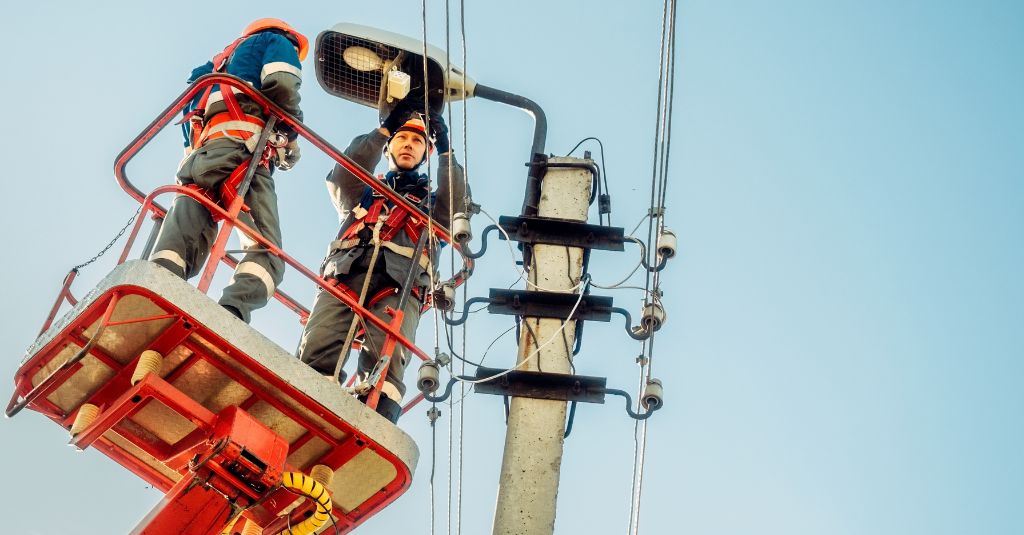
Despite the recent progress, there is still work to make heavy industries safer places to work. Workers in construction, mining, manufacturing, transportation, and in the oil & gas industry work at height or in confined spaces, risk an accident with vehicles and machines, or need to work with hazardous chemicals. Utilizing technology advancements can help to improve workplace safety even in these potentially hazardous environments.
Training in virtual reality or using robotics is one of the most efficient ways of improving workplace safety, followed by sensors, detectors, and workers’ well-being tracking wearables. However, the environments of heavy industries do pose additional requirements to the technologies. They must be durable and usable from the deepest of mines to the highest of constructions and oil rigs and fulfill all needed rules and regulations.
While the last few decades have seen significant advances in workplace safety, there is still room for improvement. Millions of people suffer injuries from workplace accidents every year.
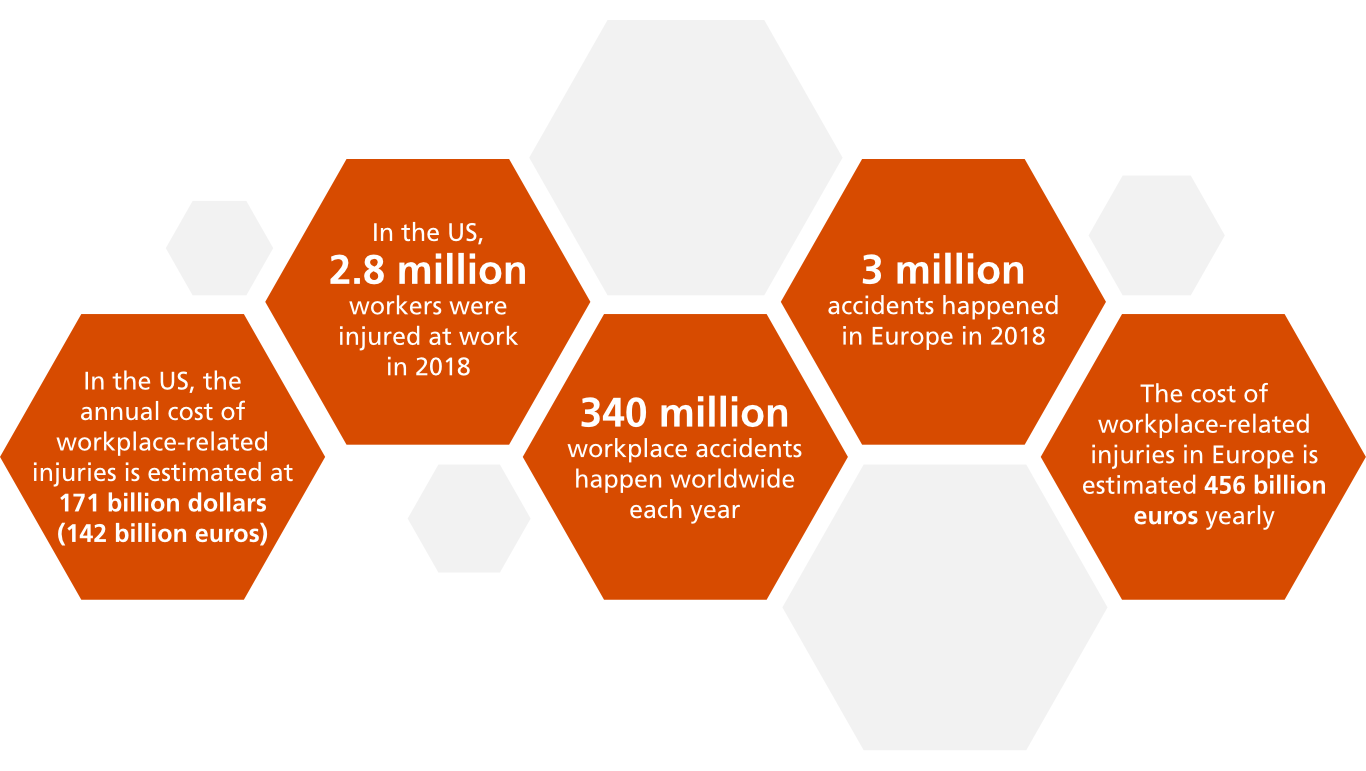
However, there are many ways to increase safety in the workplace. One of them is through adopting new technology. According to research by Karakhan, Xu, Nnaji, and Alsaffar (2018), higher rates of technology implementation can improve safety levels. The most apparent technology solution is using robotics and other automated equipment to avoid having workers perform dangerous tasks. However, the options go beyond that, from virtual reality training to workers' health monitoring wearables, such as smart helmets, sensors, and watches.
However, not all technologies are approved to protect safety. The National Safety Council (NSC) surveyed Environment, Health, and Safety (EHS) professionals and found that the most significant barriers to workplace safety technology implementation are:
Lack of information about various technologies
Lack of information about companies successfully using these technologies
A digital workplace can enhance productivity and collaboration by integrating advanced technologies like AR and VR, which improve communication, streamline processes, and provide immersive training experiences.
To help companies make their workplaces even safer, Getac wanted to bridge the information gap about suitable workplace safety technologies, focusing on the following areas:
The industries most in need of improvement when it comes to workplace safety
The most common hazards in these workplaces
Suitable technological advancements for minimizing these hazards
Companies can significantly improve workplace safety and efficiency by leveraging technology to streamline workflows and enhance productivity. Advanced analytics can transform data into actionable insights, driving strategic decision-making and promoting continuous improvement in office environments.
For this study, we concentrated on heavy industries such as construction, manufacturing, mining, and oil & gas. As seen from the latest available workplace-related, non-fatal, and fatal injury data from Eurostat below, there is much room for improvement.
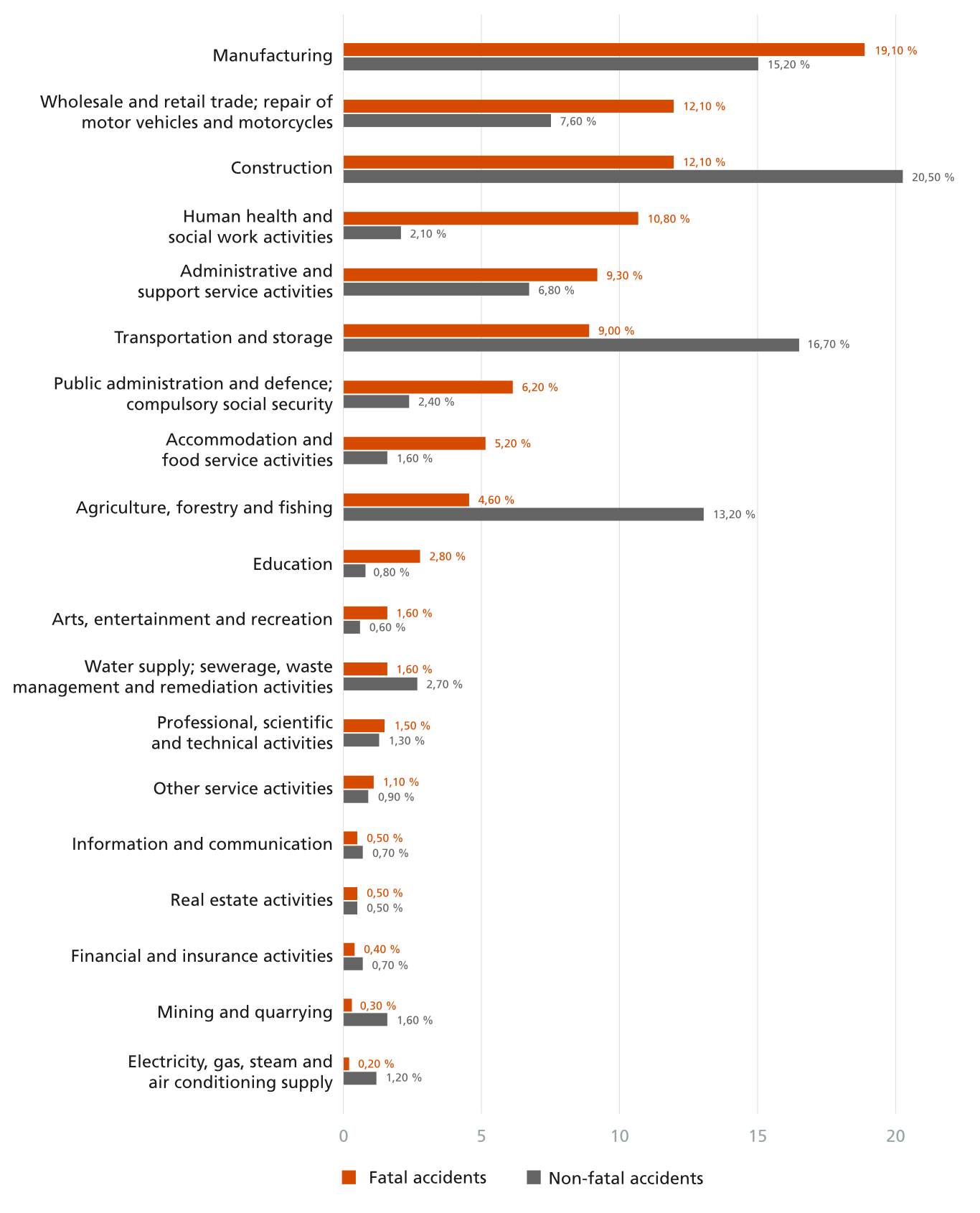
We also included the transportation industry in this report, as we noted a relatively high rate of injuries.
Eurostat lists the oil industry under manufacturing, so individual data wasn't provided. But according to IOGP, the International Association of Oil & Gas Producers, there were 31 fatalities in 2018 and 2,970 injuries from their member companies. These numbers would put the industry behind electricity.
We also examined how the number of injuries reported in these industries has changed in recent years.
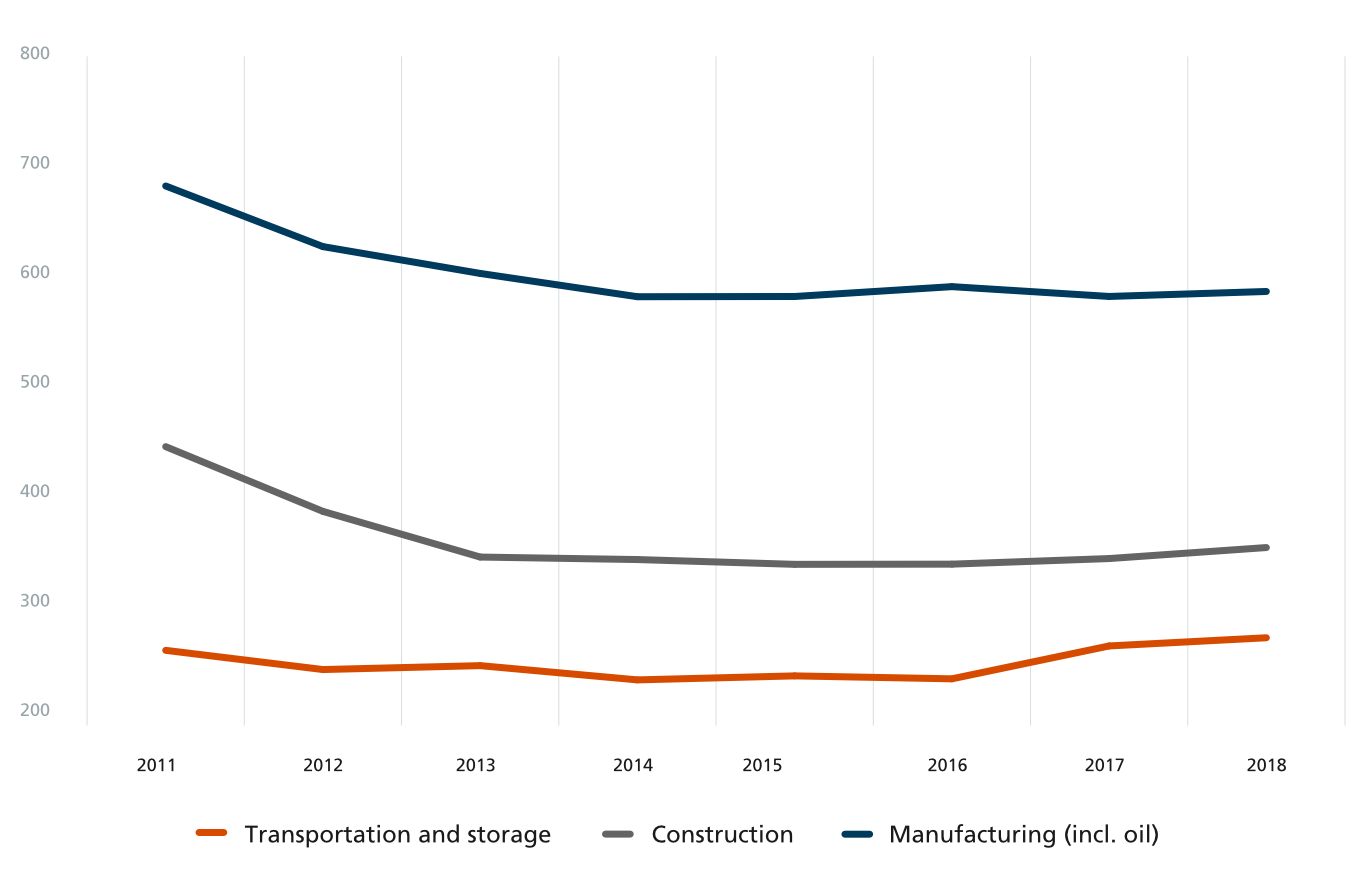
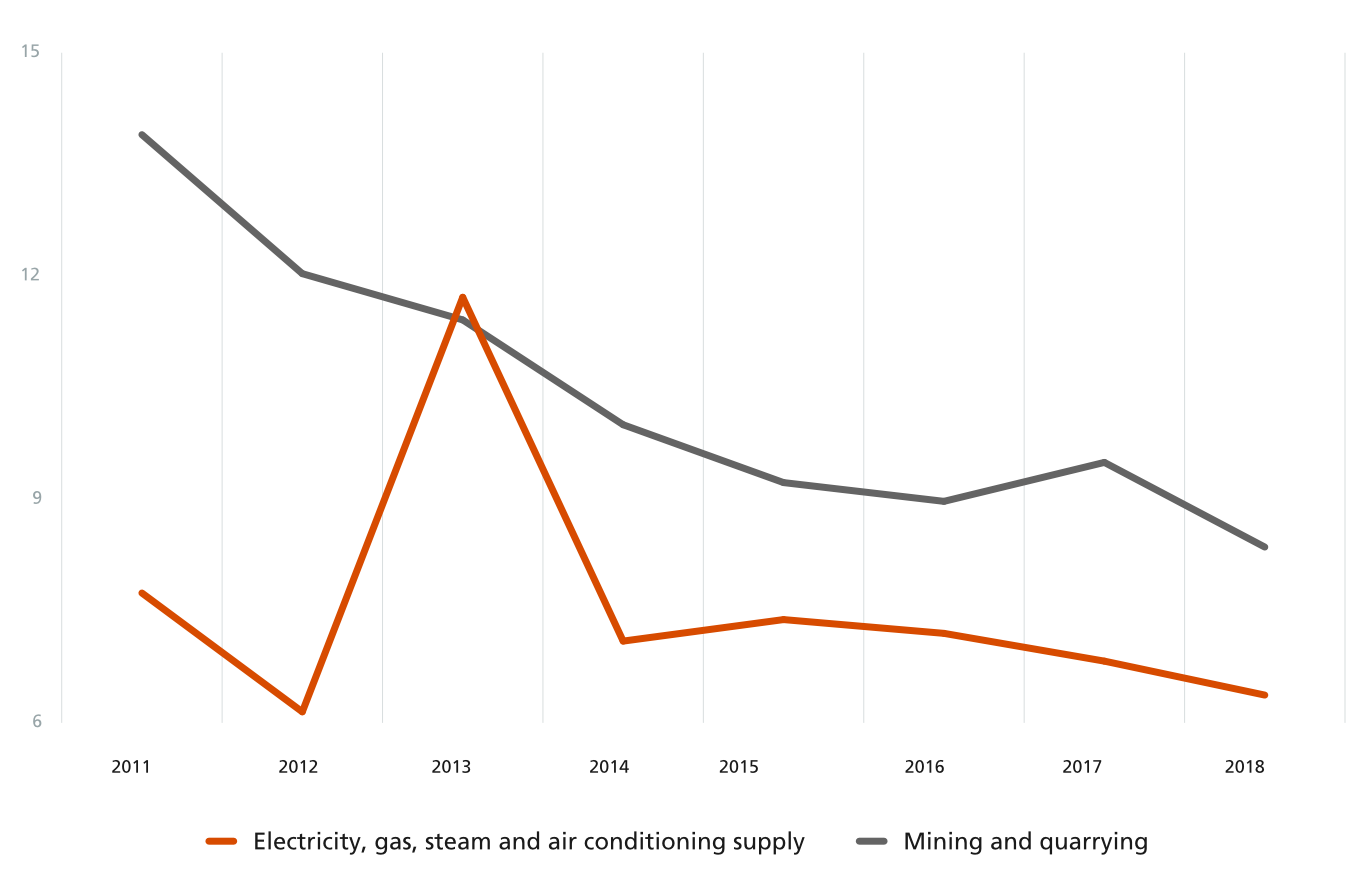
As can be seen from these graphs, non-fatal accident reductions have stagnated in some industries, with the number of injuries even increasing slightly. These industries are thus prime candidates for new workplace safety measures. Industrial automation has significantly transformed workplace safety and efficiency in heavy industries, enhancing productivity and innovation. AI integration is also becoming crucial, streamlining processes and improving decision-making.
Technology can play a crucial role in helping these industries maintain compliance with regulatory requirements. Automation and software solutions can streamline data management and compliance processes, ensuring that organizations consistently meet evolving regulations. Additionally, the increasing complexity and volume of data necessitate sophisticated strategies to prevent data breaches, making security a top priority.
We could identify multiple hazardous situations that put workers at risk of injury based on various studies, reports, and articles about workplace security across the chosen industries. The image below describes these situations. Categories relied on National Safety Council (NSC) 2019 report definitions. Digital technologies, such as IoT sensors and AI-powered analytics, enhance workplace sustainability by reducing carbon footprints and optimizing energy usage.
Remote work has significantly changed work environments and operational efficiencies. Businesses need to adapt to remote work through enhanced communication tools, increased flexibility, and the implementation of security measures to address the unique challenges of this work model. Instant messaging platforms like Slack and Microsoft Teams facilitate quicker decision-making and foster collaboration among remote teams, significantly enhancing connectivity and efficiency in modern work environments through instant messages.
Furthermore, based on industry-specific studies, such as those by Muthukumar, Janardhan, and Rajiev (2019), Hermanus (2007), and Bhattacharya & Pramanik (2020), we've further highlighted which hazardous situations are prevalent. Many of the most common dangerous problems are commonplace in all or most industries. This outcome further emphasizes the need to take workplace safety matters seriously.
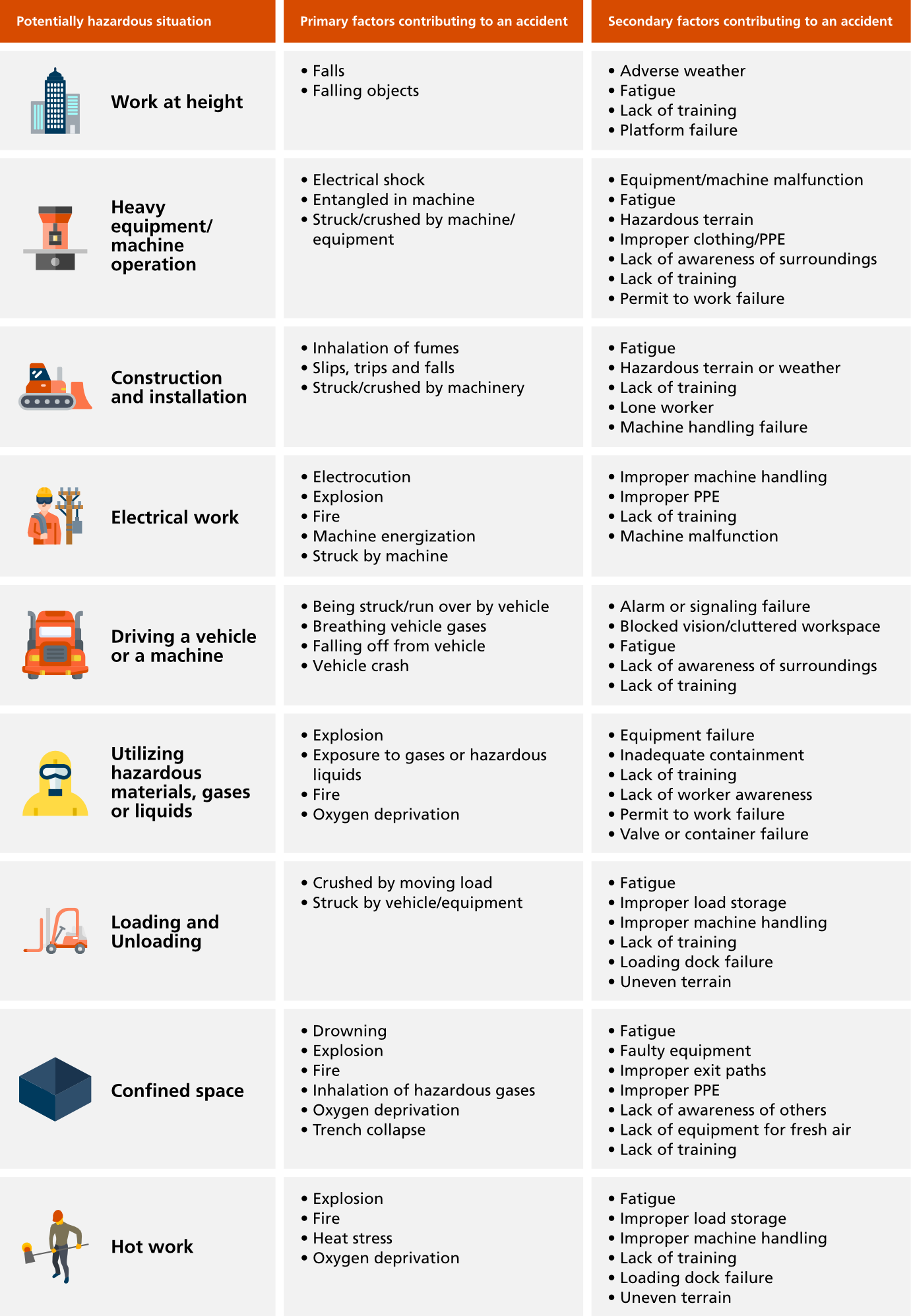
Along with data from the US Bureau of Labour Statistics, the NSC interviewed 32 EHS professionals from different industries. The participants mentioned work at height (50% of the interviewed said), electrical work (50%), machinery operation (34%), heavy equipment operation (25%), and confined space entry (25%) to be the most hazardous situations in their workplaces. As mentioned in other target industry studies, additional injuries observed were:
construction and installation
operating a vehicle
utilizing hazardous materials, gases, or liquids
loading and unloading
hot work
Like the NSC report, we further categorized risk factors for each hazardous situation as primary or secondary. Immediate risks are directly associated with the event, such as falling when working at height.
There can, however, be more reasons behind the primary risk, such as why the person fell in the first place. Many of the studies and articles mentioned the following secondary factors that could create a hazardous situation:
Human error or fatigue
Neglecting safety procedures such as the use of protective equipment or not keeping the work environment clean
Lacking or inadequate training
Forces beyond human control, like heavy rain flowing into a mine
It's challenging to find one single solution to tackle these factors. Many of them reflect the attitudes of the whole organization towards workplace safety. Their impact needs to be considered, and luckily, many technological solutions can help diminish the effect of these secondary factors.
After identifying the most common safety hazards in the chosen industries, we mapped them with suitable technical solutions. As this report focuses on technology, standard protective equipment such as hard hats, harnesses, or rugged work boots are omitted. AI-powered analytics can provide real-time insights into environmental impact and employee performance, supporting organizations in optimizing processes and reducing their carbon footprint.
From looking into interviews and surveys on EHS professionals about safety technologies, we got an idea of what technologies the professionals themselves are already using or would like to use more frequently. The professionals interviewed by the NSC mentioned a long list of technologies they are already using.
The modern office has been transformed by advancements in automation and virtual meetings, redefining the traditional workplace and significantly impacting productivity and efficiency. A hybrid work environment has become a crucial aspect of modern workplace strategies, enabling flexibility and adaptability for employees, thus enhancing employee productivity by reducing commuting and office distractions.
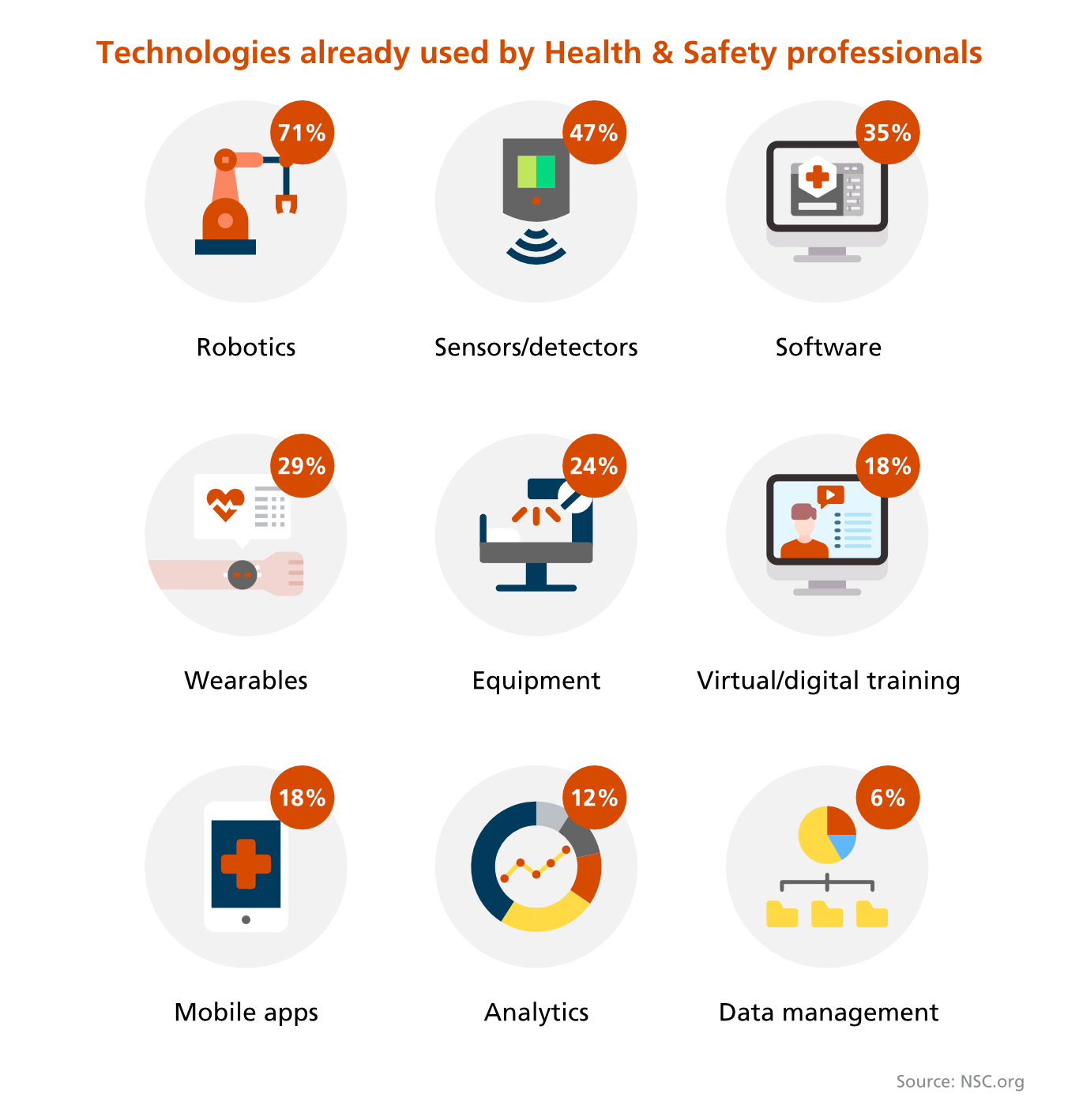
The interviewees could use more than one technology in their responses. So, the percentages correspond to the number of participants who mentioned the technology and will total above 100.
Based on an interview by the research and advisory company Verdantix, EHS professionals think these three technologies show the most potential:
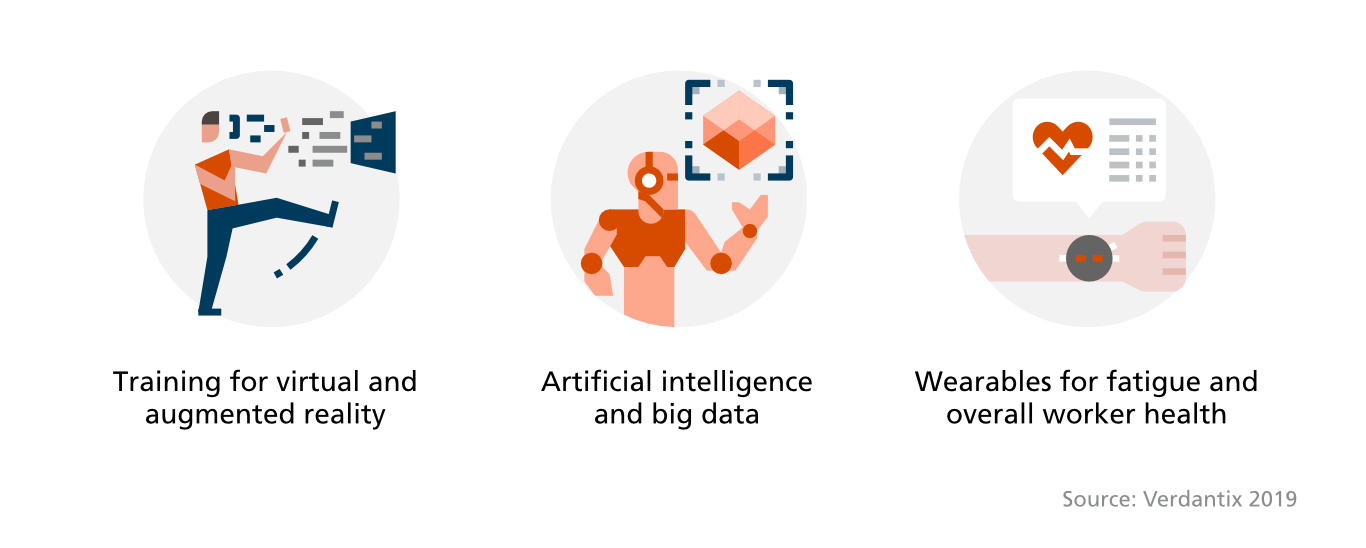
Automation through robotics proved to be the most common technology, followed by various sensors and software. The growing interest in virtual and augmented reality is also understandable, as these technologies have gained more media popularity. Training for hazardous situations through virtual or augmented reality was also mentioned in various studies across industries as a great way to prepare workers for possible dangers safely. Technological tools, particularly space management apps and platforms, significantly enhance flexibility and operational efficiency by automating routine tasks, allowing employees to focus on more strategic work.
Artificial intelligence (AI) refers to computer-equipped machines operating large data sets through algorithms, enabling them to perform tasks or solve problems on their own. Intelligent industry machines can thus learn from the data given to them and be able to provide predictions for possible future scenarios.
Augmented reality (AR) allows a person to experience the world with augmented sensor inputs, such as computer-generated overlays or forms. AR can be used to send worker safety information (e.g. training materials) to be viewed via devices like special glasses.
Automation and robotics refer to equipment or machine designed to perform tasks partly or entirely instead of the worker. Examples are drones, semi-automated vehicles for moving items, or robotic drills.
Big Data refers to analysing and extracting information from data sets too big for traditional data analysis software. It can be used to gather and analyse machine or worker well-being information, for better decision-making.
Virtual reality (VR) provides a computer-generated interactive simulation of a scenario. In virtual reality safety training, the worker can go through a simulation of an accident situation realistically and stay completely safe.
Analyzing data from industrial machines to working environments can only be expected to become even more popular in the future. Machine malfunctions or adverse weather can more easily be anticipated through analytics. Also, monitoring workers' well-being through wearables can help reduce fatigue-related risks.
However, some technical solutions more effectively increase safety than others. From the data, we could establish a hierarchy of technological effectiveness to determine which solutions one should concentrate on:
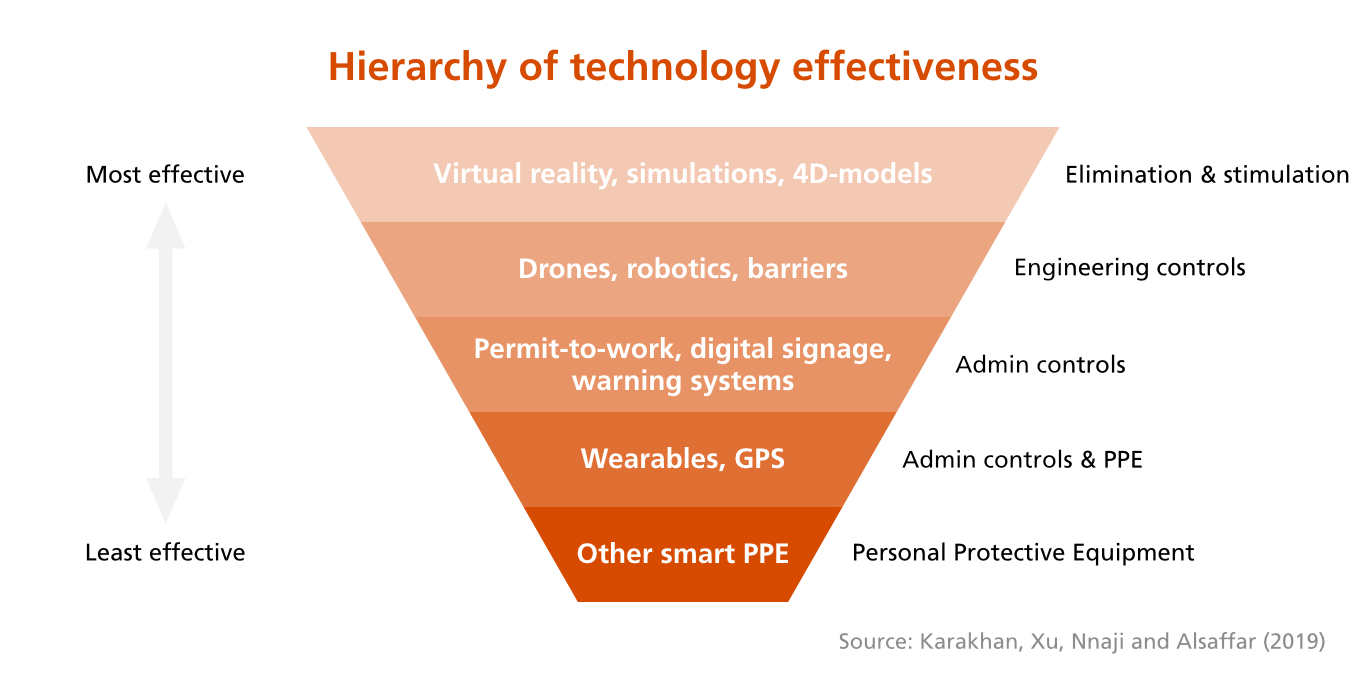
This graph shows that moving the worker from a potentially hazardous situation can help significantly improve workplace safety. According to the research of Cameron & al. (2018), the increased usage of robotics and automatically driving vehicles, such as drones, can help to reduce workplace-related injuries by up to 11% by 2030. Drones and robotics won't just allow the worker to step away from dangerous situations. These machines can also take care of dull and repetitive tasks. This change, in turn, could help keep workers more alert during the working day and diminish the risk of injuries related to fatigue or carelessness.
Virtual reality helps organizations remain competitive by utilizing modern technology. It also plays a crucial role in enhancing office environments by improving efficiency and productivity.
The next-best options are engineering or admin controls such as sensors and barriers and other data-collecting items like wearables. Digital devices can also help workers pay more attention to safety workflows and procedures in their workplace. Employees can get reminders to wear protective equipment through their wearables or notifications when entering hazardous areas.
The least effective safety technologies are smart PPEs or technology-enhanced personal protective equipment, such as smart helmets, smart glasses, or fatigue monitors. They can send information about workers' well-being straight to managers.
Wearables and smart PPE are intelligent wearable technologies that obtain information about a worker's surroundings, location, or well-being. Examples are watches, smart helmets, or sensors on vests, which can send alerts for hazardous gas exposure, signs of fatigue, or information about working posture and vital signs.
However, these sensors and PPE are only effective when used correctly. If a worker does not stop to take a break even when their smart PPE tells them to, the equipment can't be said to have positively impacted workplace safety.
Additionally, wearables and smart PPE contribute to office space optimization through advanced technologies by analyzing usage patterns and enhancing employee experience.
Below, based on the framework from the NSC report and further studies and articles on technologies used in manufacturing, construction, transportation, mining, and the oil & gas industry, we've created the following visualization of relevant technologies for each of the most common hazardous situations.
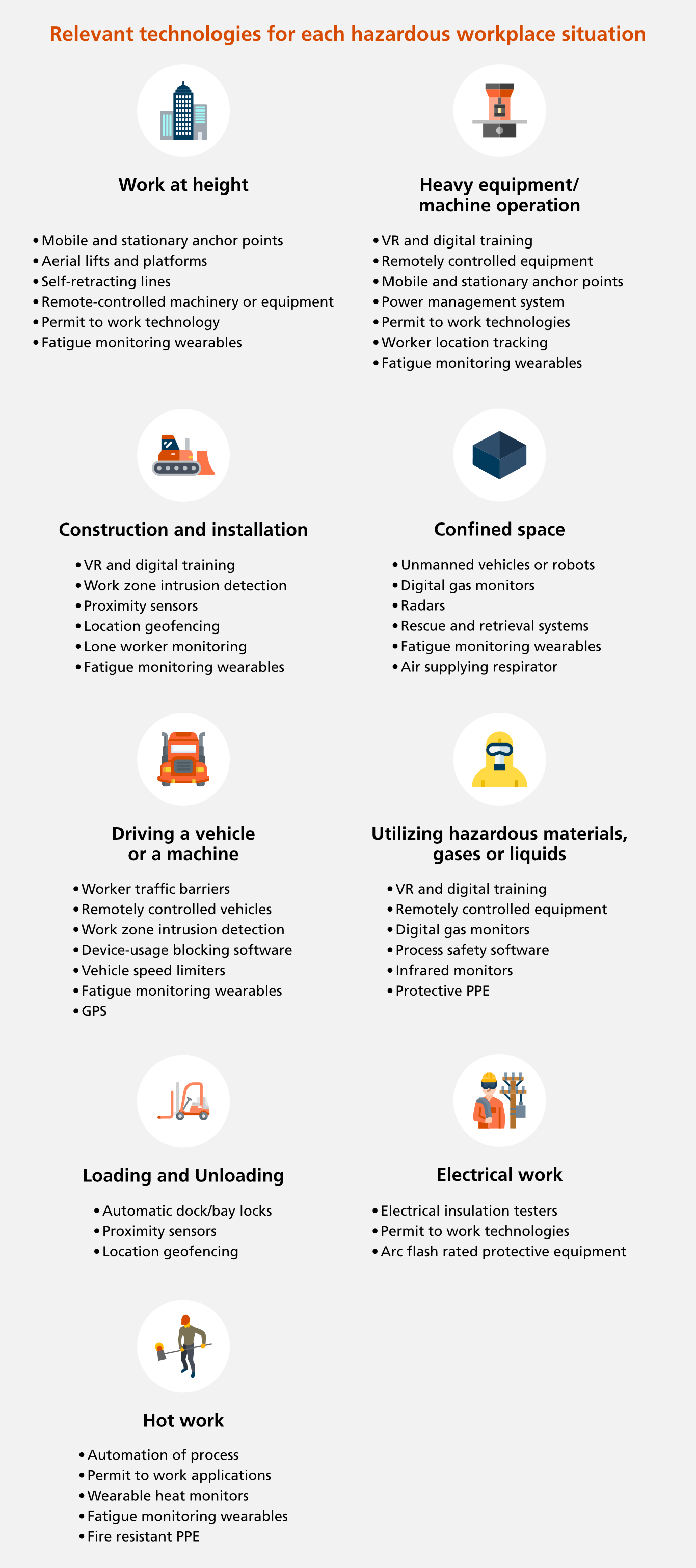
Adopting innovative technology enhances safety and leads to significant cost savings by improving operational efficiencies and reducing expenses. These technologies help businesses analyze usage patterns, adapt real estate needs, and minimize wasted space, ultimately lowering costs. Optimizing resource usage through advanced technologies and IoT devices can significantly improve resource efficiency and contribute to greener office practices.
We've used the hierarchy for the different solutions better to visualize the effectiveness of each solution for each risk.
Users can employ certain technologies to address multiple different risks. For example, as fatigue is a common secondary risk factor in many hazardous situations, wearables for tracking employee fatigue levels are often present in the graphic.
This graphic overviews the technologies available beyond the industries observed in this report. However, as the heavy industries in this study are all unique, we've also illustrated efficient technologies and their use cases individually for each industry. Adopting the right tools to enhance workplace productivity and security is crucial, ensuring that modern workplaces can efficiently mitigate risks associated with remote work and cyber security challenges.
Permit-to-work technology provides authorized personnel access to certain areas or permission to work on specific tasks only. The software can ensure that only people with the required training and certification can perform particular tasks, such as handling dangerous substances. Modern workplaces are being transformed through advanced technologies that enhance energy efficiency and promote sustainable practices, integrating communication tools and IoT devices to improve operational efficiency and foster better collaboration and work-life balance for employees.
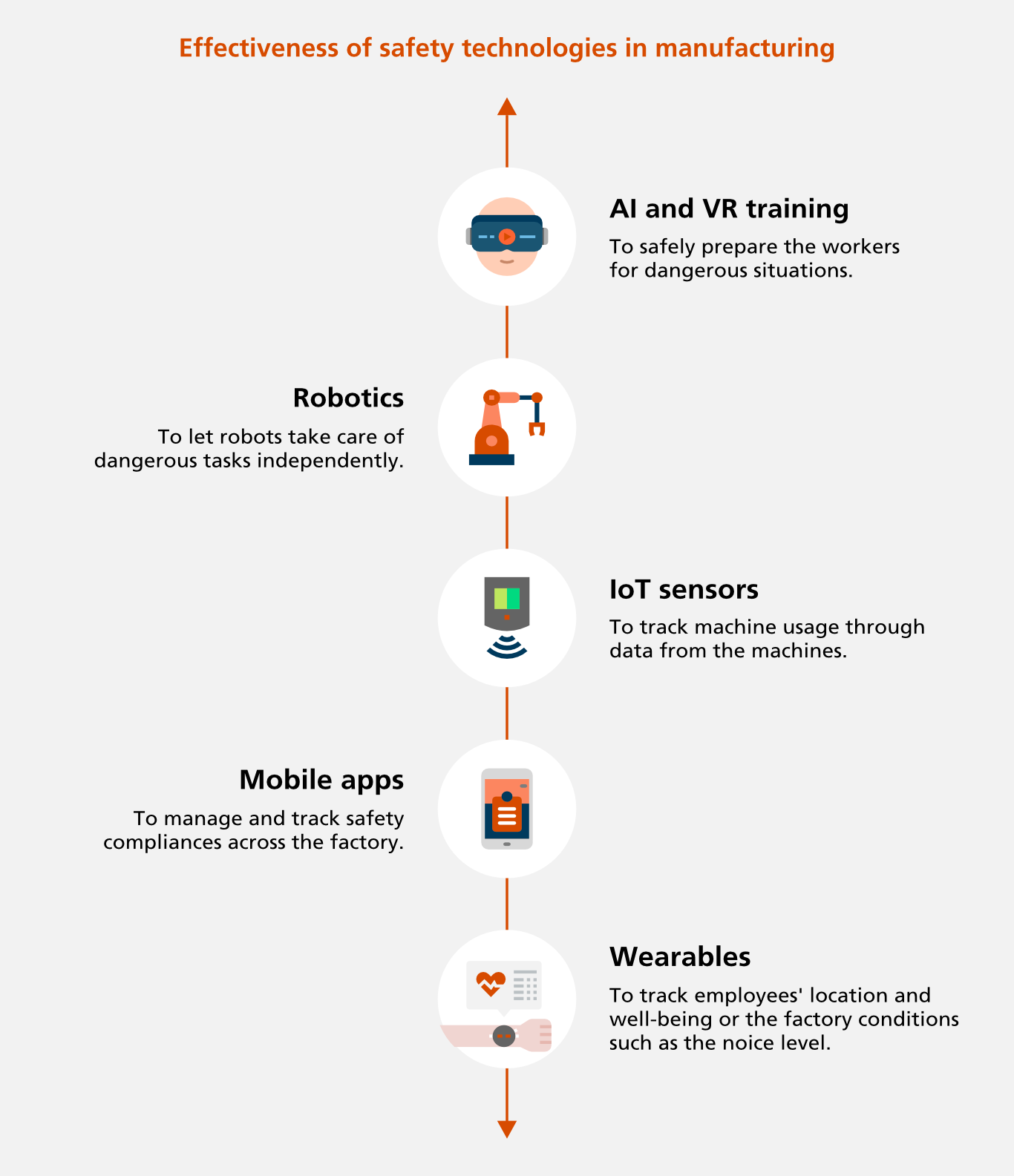
Most factories today are partially automated, but the benefits of technology to manufacturing don't stop there. Through IoT sensors, managers can receive real-time data from the machines and be alerted when maintenance work is needed. Advancements in technology have enabled businesses to adopt remote work strategies, allowing for greater flexibility and collaboration. Cloud computing facilitates enhanced data storage, sharing capabilities, and optimized workflows, making it essential for companies to stay competitive and enable flexible work arrangements in today's digital landscape. Leveraging modern technology tailored to specific business needs can significantly enhance workplace operations and overall business value.
IoT or Internet of Things refers to physical objects, such as connected vehicles, attached with sensors, monitors, and processing software, to connect & send data to other devices via the Internet. It enables people to monitor the work of machines and equipment remotely and to use automated controls such as off switches for the entire work environment. Digital services enhance workplace efficiency by improving communication and collaboration through these connected technologies.
Other trends in manufacturing indicate a multitude of different technology solutions. Examples of these are high-technology wearables to monitor workers' posture and the noise level of the factory floor. Another promising possibility is virtual reality programs to train workers to deal with hazardous situations and accidents. Getting clothing or body parts entangled in a machine is extremely dangerous. Wearable sensors can alert workers if they are standing too close to a device or otherwise not following safety protocols.
With fatigue-monitoring wearables, workers can have breaks when needed or have high-concentration demanding tasks when they are the most alert, according to the fatigue data.
According to recent studies and research, there is plenty of room for improvement in safety technology in construction. This opportunity exists because the construction industry generally lags behind other industries in technology adoption. However, the industry can benefit from different technologies in multiple ways, presented in the graphic below.

Organizations can use VR training to train workers about complex or dangerous tasks. Doing so would better prepare them and decrease the risk of accidents and injuries. Working remotely has evolved from an uncommon practice to a mainstream norm post-pandemic, impacting office culture and employee interactions in the construction industry. Innovative technology has enabled greater flexibility, attracting a wider talent pool while reducing operational costs. Hybrid working has emerged as a standard practice, necessitating organizations to adapt their strategies to accommodate both in-office and remote employees.
Software such as 3D/4D computer-aided design (CAD), building information modeling (BIM), and laser scanning can help identify hazards from afar.
Proximity sensors can reduce the risk of collisions or falls. This technology can alert workers when an object, such as a piece of machinery or a person, enters set proximity.
Location geofencing detection can alert workers when entering a potentially dangerous worksite zone. This limits accidents arising from disregarded safety procedures in high-risk areas. Work zone intrusion detection will alert workers if unauthorized people enter the work area without permission.
Robotics and automation, such as crewless aerial vehicles, can be used when work needs to be done high above the ground.
Wearables can monitor lone workers, prevent collisions with machines, and help find all employees faster in an emergency. They can also help prevent or reduce health risks from exposure to high temperatures during hot work for too long. Remote collaboration enhances communication and teamwork, making it more interactive and integrated into everyday work processes.
3-D/4-D computer-aided design (CAD) uses the help of computer technology to design or create technical documents in either three or four dimensions. It helps engineers and architects better visualize the construction process and identify potential errors in the plan. Integrating sophisticated tools in CAD enhances productivity and security by streamlining operations and addressing cybersecurity challenges effectively.
Building information modeling (BIM) can use laser scanning to accurately create a digital presentation of a physical building or a construction site. It can be used to identify and assess potential hazards safely from afar.
Additionally, BIM enhances communication and collaboration by utilizing digital tools to maintain strong connections among remote teams, streamline interactions between employees and customers, and increase productivity through quick and effective information sharing.
Proximity sensors will sense if an object or a human gets too close to another object or human or enters a restricted area. They help achieve the right balance between integrating technology and maintaining the human element in the workplace.
Location geofencing triggers an action when a device enters a set area. It can alert workers through apps or wearables that they are about to enter a restricted or hazardous area at work or to stop unauthorized people from entering a construction site.
Additionally, location geofencing enhances employee experiences by improving productivity and engagement.
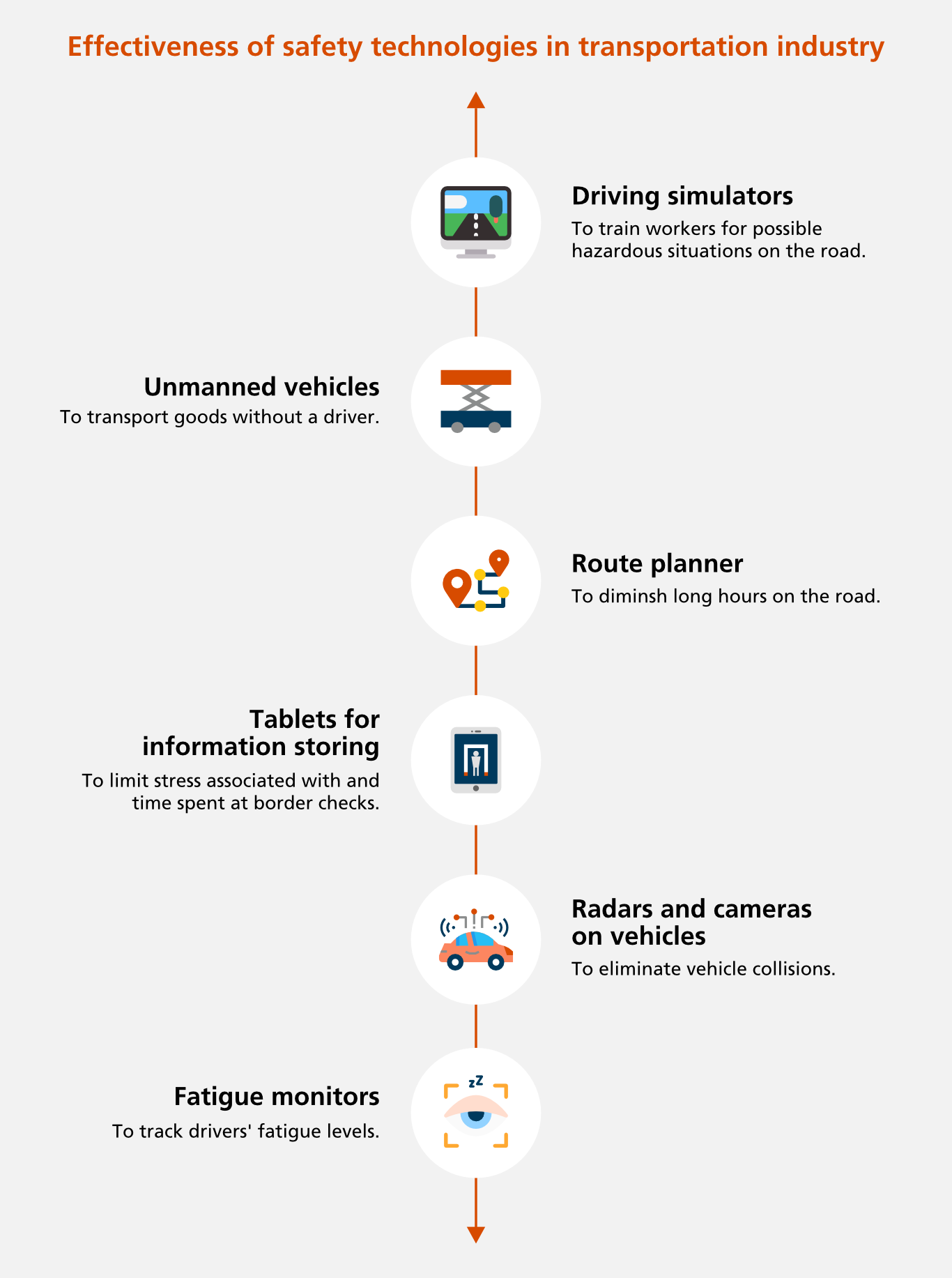
The most used safety technologies in transport are sensors, cameras, and devices monitoring obstacles and speed.
Also, in transportation, eliminating the human factor with crewless vehicles such as connected vehicles (CV) or automated vehicles (AV) can significantly reduce road accidents. Organizations in the industry can employ software installed in cars. The software will help stop drivers from using digital devices and demand them to stop for breaks.
Key data needed for crossing borders can be saved conveniently on digital devices, helping avoid stress and long waiting periods at customs while benefiting the worker's well-being.
Also, VR training can prepare drivers for various hazardous driving scenarios and protect them in dangerous situations on the road. Adopting new workplace technologies can significantly enhance worker productivity by improving operational efficiency and creating an engaging and adaptive work environment. Additionally, technological advancements have significantly enhanced the customer experience by improving communication and collaboration within teams, which in turn helps improve productivity.
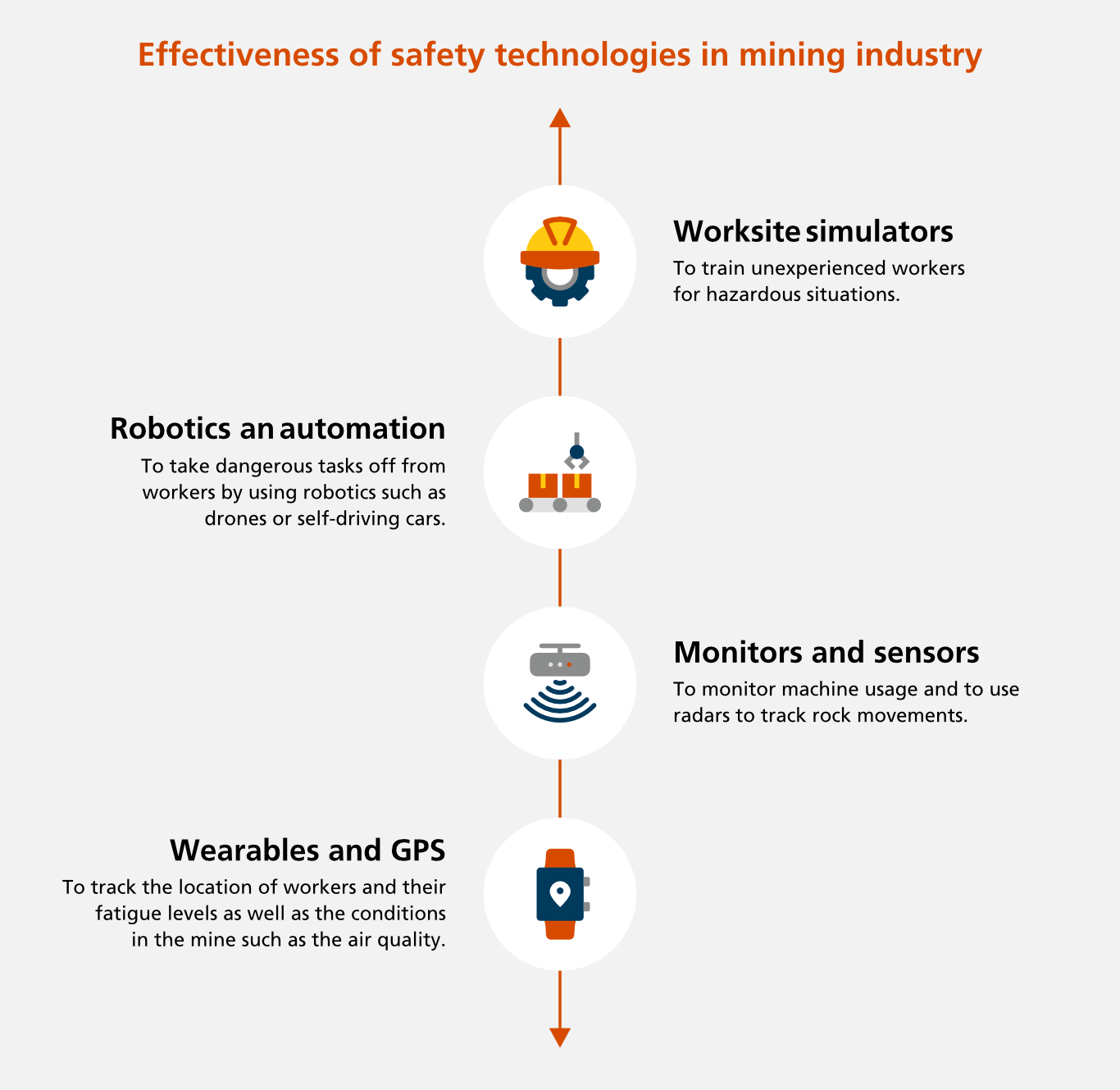
For mining, the most mentioned and most effective technologies are the ones that can help to remove the workers from potentially hazardous situations or to alert them.
Worksite simulators can provide training without exposing inexperienced workers to hazardous environments.
Robotics and automation, such as self-driving trucks or robotic drills, enable workers to avoid hazardous situations and environments. Drones can take images inside mines in areas with the risk of collapse and replace labor-intensive survey, inspection, or mapping activities.
Sensors and monitors can also help make mining safer. By monitoring rock movements, workers can receive warnings regarding potentially dangerous seismic activity. Radar can identify workers underground and assist in planning drilling and controlled demolitions. Monitoring usage patterns of heavy equipment through radio-frequency identification can aid the scheduling of part replacement, fluid change, or maintenance optimization.
Wearables can also benefit workers in multiple ways. They can detect environmental hazards, including poor air quality, and emit a warning signal early on for potentially harmful or dangerous situations. They can also help locate workers in mines during an emergency and keep tabs on their fatigue levels. Project management software helps organize tasks and align teams, ensuring all safety protocols are followed efficiently.
Radio-frequency identification (RFID) uses radio waves to transmit information about objects or to locate people. It can be used to track lone workers in a mine or monitor heavy equipment usage for possible repairs.
Integrating advanced technologies like RFID into the workplace can significantly boost productivity by streamlining operations and enhancing efficiency.

As in other industries, drones and robotics can help prevent accidents while extracting oil and gas. They can be used, for example, in oil tank inspection or other dangerous maintenance jobs, to get a better overview of the site.
IoT can be used to gather data from machines and keep an eye on performance. Monitors can be placed on-site to track the levels of hazardous gases in the air. Environmental monitoring is essential in confined spaces. Additionally, the oil and gas industries' GPS systems and other wearables can help to track employees' location and well-being on-site, even onshore.
Special attention has also been given to vehicle collisions. These make up a significant proportion of accidents in the industry due to the long distances involved. Technologies like radar, 360-degree cameras, digital device usage-blocking software, or fatigue-tracking wearables can help improve safety when driving from site to site. Strategic work enabled by these technologies allows employees to focus on more value-added activities, enhancing engagement and productivity.
The heavy industries studied in this report pose specific strains for people and the equipment used in the industries. EHS professionals interviewed in the NSC survey were especially concerned about the different technologies' adaptability to their industries' special requirements. Thus, equipment used in these working environments must be equipped for unique stresses.
Additionally, protecting sensitive data in these hazardous environments is crucial. Businesses must implement strong security measures and technology solutions to securely manage and store sensitive information while adhering to compliance regulations. Addressing data privacy is essential when adopting new technologies in these environments to ensure the security and integrity of organizational information. To stay ahead, businesses need to embrace and strategically implement new technologies to maintain a competitive edge and meet the demands of their customers effectively.
First, devices must be robust and able to take hits or drops. Of course, when a person accidentally falls from a height, what happens to the device they carry is unimportant. Workers who know their device can withstand a fall may not be as likely to try to catch it. However, the instinct to try to catch a falling, expensive device poses a risk of them falling after it themselves.
Devices must also work correctly in diverse conditions. A mine or construction site can be filthy and loud. Therefore, the products used in these environments must withstand dust, sand, vibrations, and moisture build-up. Additionally, there might be minimal sunlight coverage at oil fields or construction sites. For workers to follow visually-prompted instructions, the screen must be bright enough to be visible under direct sunlight. Robust and durable technology in the workplace is essential for ensuring efficiency and safety in such challenging environments
All workplaces must comply with the laws and regulations of the country where they operate. The European Union also has a list of directives related to safe and healthy working environments, which its member states must consider. Integrating third-party systems is essential for achieving and maintaining compliance with these regulatory requirements.
The workplaces in the industries chosen for this study can also be classified as hazardous work environments. Working in mines, on oil rigs, or transporting dangerous substances such as gasoline poses an increased health and safety risk for the workers, making it crucial that equipment used in these environments doesn't add to that risk.
For example, all products and equipment used in hazardous environments with potentially explosive atmospheres must be certified in America and Europe. Certificates such as UL and C-UL in North America and ATEX in Europe ensure products are used in workplaces with potential fire or an explosion.
ATEX is the EU directive for the required safety procedures needed in hazardous environments where a risk of an explosion is present. It sets special requirements for all equipment used in these environments. Businesses must adapt to digital transformation to meet these regulatory requirements, ensuring that technological advancements are integrated without compromising safety standards.
UL/C-UL are globally recognized certifications for products used in hazardous environments granted by the North American company UL.
Integrating certified technologies enhances workplace efficiency by streamlining processes, optimizing resource allocation, and improving team collaboration, ultimately leading to increased productivity and a better overall work environment.
Safety products cannot get in the way of everyday work. They should be light and easy to carry in a tight mine elevator or climb a construction ladder. Employees also must use or wear them alongside their regular safety gear. Items like touch screens must be usable while wearing gloves.
In hazardous environments, teams must communicate back and forth, below and above ground (mines) or on land (oil rigs). The devices one uses must have long battery life and strong WiFi/4G/LTE signal. In environments where getting a signal is impossible, other ways of transporting data and information, such as Bluetooth, must be standard.
Whether deep in a mine, at elevation on a construction site, or with a flat tire in the middle of nowhere, employees must be reachable and not struggle with their devices. GPS makes it possible to track employees, especially if they need to work alone, further increasing worker safety.
Additionally, addressing cybersecurity risks is crucial when using technology in these hazardous environments to ensure the safety and security of both data and personnel. The increasing complexity and number of cyber threats associated with technological advancements necessitate strong cybersecurity measures and training. By minimizing time-consuming processes, organizations can enhance productivity and allow employees to concentrate on more strategic business activities.
It's impossible to prevent workplace-related injuries completely. However, several technologies are available for companies of different sizes to improve workplace safety. Digital tools enhance productivity and efficiency by automating once-manual processes, allowing organizations to focus more on safety measures. Additionally, employees can choose flexible working arrangements, including the traditional office, to better fit their lifestyles and job roles amid the rise of hybrid working models.
Many of the most effective technologies for preventing workplace injuries aim to remove the worker from the dangerous task altogether. Automation replacing human workers is often perceived rather negatively. However, it should be welcomed in cases where it can improve workplace safety.
However, technology has its limits. Many injuries result from human error, such as negligence of safety procedures or fatigue. Monitors, wearables, and reminder apps can help workers remember to use their protective gear. Such devices enable managers to monitor employee levels of alertness. However, it's the managers' job to organize shifts and working procedures to ensure employees stay as safe and alert as possible.
Similarly, it's the managers' job to ensure workers have the necessary skills, as insufficient and inadequate training poses a significant risk. Something unexpected can always happen, but one can be prepared thanks to technology. With virtual and AI training, workers can safely practice for hazardous situations and be ready if something goes wrong.
Lastly, new technologies must adapt to different industries' specific needs and requirements. The devices must comply with the rules and regulations set by other countries, states, and global organizations. These devices can't become risk factors, for example, in explosive environments. Manufacturers of these technologies must be aware of all these risks and what these environments are like to improve workplace safety. Integrating workplace technology is crucial to staying competitive and efficient in a rapidly changing digital landscape.
Hermanus, M.A. (2007), Occupational health and safety in mining—status, new developments, and concerns”, Hermanus, The Journal of The Southern African Institute of Mining and Metallurgy
Horton J, Cameron A, Devaraj D, Hanson RT, Hajkowicz SA (2018) Workplace Safety Futures: The impact of emerging technologies and platforms on work health and safety and workers’ compensation over the next 20 years. CSIRO, Canberra.
Karakhan A., Xu Y., Nnaji C. and Alsaffar O. (2018), Technology Alternatives for Workplace Safety Risk Mitigation in Construction: Exploratory Study, Conference: Proceedings of the 35th CIB W78 2018 Conference: IT in Design, Construction, and ManagementAt: Chicago, IL
National Safety Council, 2019, Safety Technology 2020: Mapping Technology Solutions for Reducing Serious Injuries and Fatalities in the Workplace.
TOP 5 SAFETY INNOVATIONS IN MINING
Five Ways Hazards Are being Combated In The Oil & Gas Industry
Subscribe below to be kept up to date on the latest industry and technology trends. We will send you a monthly blog round-up direct to your inbox.